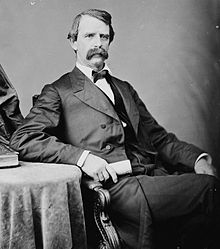Erastus Wells
| Erastus Wells | |
|---|---|
 |
|
| Member of the U.S. House of Representatives from Missouri's 1st & 2nd district |
|
|
In office March 4, 1869 – March 3, 1873 (1st) March 4, 1873 – March 3, 1877 (2nd) March 4, 1879 – March 3, 1881 (2nd) |
|
| Preceded by |
William A. Pile (1st) Gustavus A. Finkelnburg (2nd) Nathan Cole (2nd) |
| Succeeded by |
Edwin O. Stanard (1st) Nathan Cole (2nd) Thomas Allen (2nd) |
| Personal details | |
| Born | December 2, 1823 Sackets Harbor, New York, USA |
| Died | October 2, 1893 (aged 69) St. Louis, Missouri, USA |
| Political party | Democratic |
| Spouse(s) | Isabella Bowman Henry Wells |
| Profession | Politician, Businessman |
Erastus Wells (December 2, 1823 – October 2, 1893) was a 19th-century politician and businessman from Missouri. Wells was born in Jefferson County, New York and was the only son of Otis Wells, a descendant of Hugh Welles, an early colonist of Wethersfield, Connecticut. Otis Wells was a farmer and died when Erastus was only fourteen. Erastus was the grandson of Ethelinda Otis and a relation of John Otis, who helped found the town of Hingham, Massachusetts in 1635. Other notable relatives include James Otis, a successful lawyer, Harrison Gray Otis, a statesman and orator, Samuel A. Otis, one of the framers of the constitution of Massachusetts, and George Otis, a clergyman and author.
Wells married Isabella Bowman Henry, daughter of Captain John Henry of Jacksonville, Illinois, in 1850. Isabella and Erastus Wells were the parents of three children, including former St. Louis Mayor Rolla Wells. Well's first wife died in 1877 and he was later remarried to Mrs. Eleanor P. Bell of St. Louis in 1869.
Wells lived on a farm and attended district schools from ages 12 to 16. At 16, Wells left the farm and moved to Watertown, New York, later moving on to Lockport, New York. He moved to St. Louis, Missouri in September, 1843. After being inspired by the omnibuses he observed in New York, he established the first omnibus line in St. Louis with the help of Calvin Case, a prominent resident of St. Louis. The omnibus was the first of its kind west of the Mississippi. In 1850, Wells and Case partnered with Robert O'Blennus and Lawrence Matthews on the bus lines. One of the most profitable lines for the business was a coach to Belleville, Illinois. After the success of the bus lines, Wells helped in organizing another transportation venture, the Missouri Railway Company, and served as its president until 1881. The first Missouri Railway Company car operated on July 4, 1859. Evidence of Wells' changing profession can be seen in the St. Louis City Directories, in which he is listed as omnibus proprietor in 1859 and as pres. Mo. R.R. Co. in 1864. Wells eventually sold his interest in the Railway Company, but moved on to many other prominent positions. He was president of the Narrow-Gauge Railway, director in the Ohio and Mississippi Railroad, president of the Accommodation Bank, director and vice-president of the Commercial Bank, and president of the Laclede Gas-Light Company. Wells also had a part in the erection of the Southern Hotel.
Erastus Wells' political career began in 1848, with an election to City Council. He retained his seat there for fourteen years until he resigned to take his seat in Congress in 1869. As a member of City Council, Wells was elected Chairman of a Special Committee on Water-Works to initiate the building of a new water-works in St. Louis. Other members of the committee included Thomas C. Chester and L.W. Mitchell. As Chairman, Wells visited several cities, including Boston, New York, and Washington, to research other water-works systems. After returning to St. Louis, the committee drafted a report of their findings, which spurred the Legislature to pass an act authorizing the City of St. Louis to fund the construction of a new water-works, at a cost of three million dollars. He also made note of police systems in the cities he visited, as he thought the police system in St. Louis to be inadequate. Based on a metropolitan police bill passed by the Legislature of Maryland, Wells adapted it to fit the laws of Missouri and submitted the bill to the state Legislature during the 1860-1861 session. The Governor, Claiborn Jackson, signed the bill, beginning a new era for the St. Louis metropolitan police system.
...
Wikipedia
